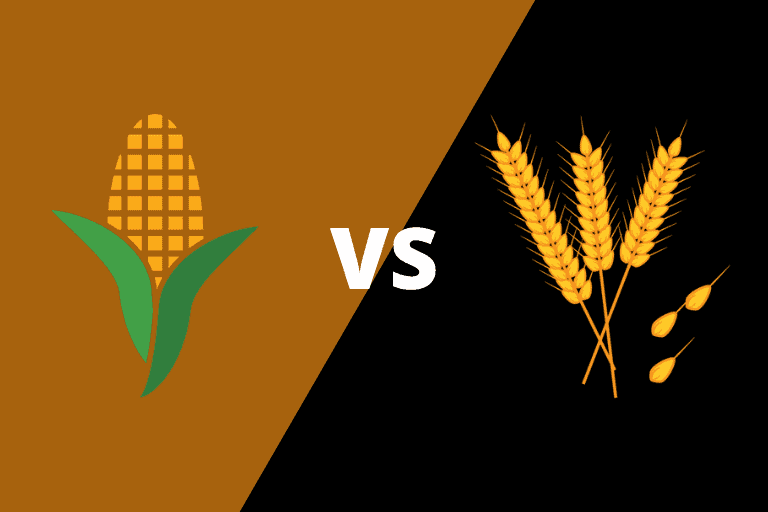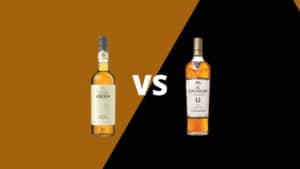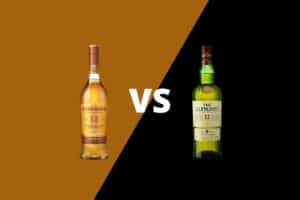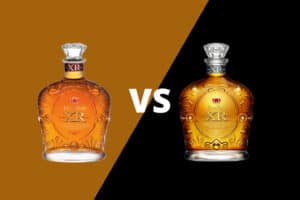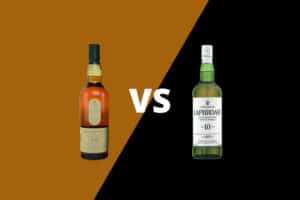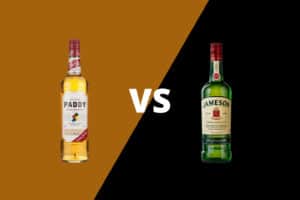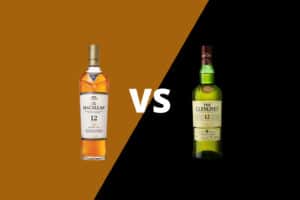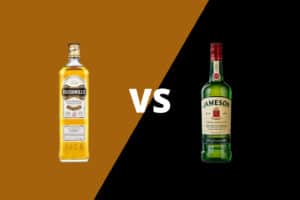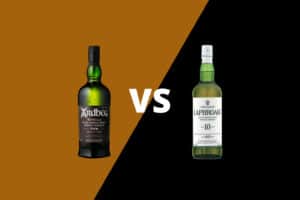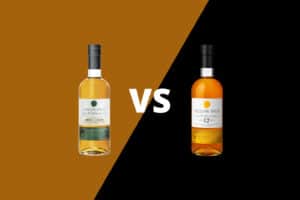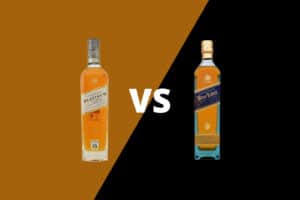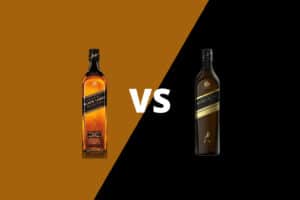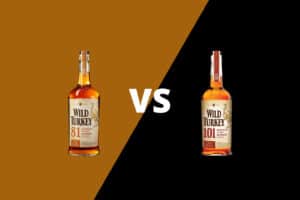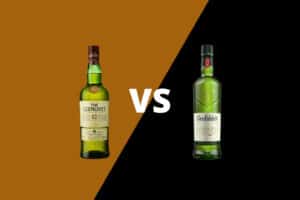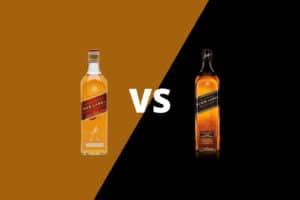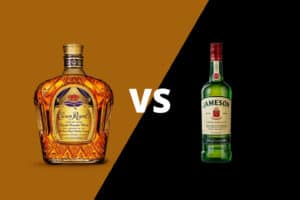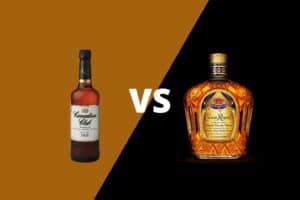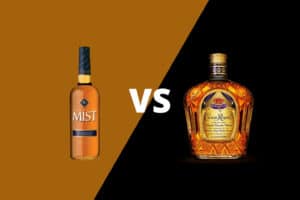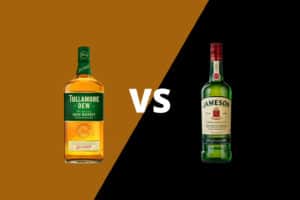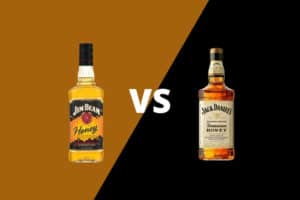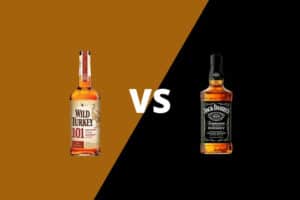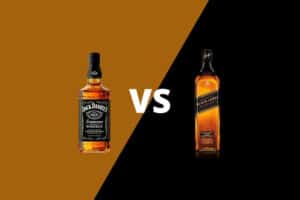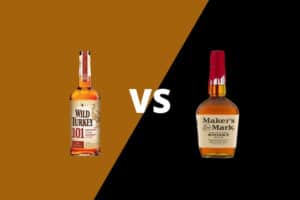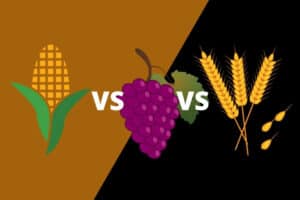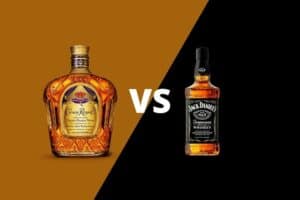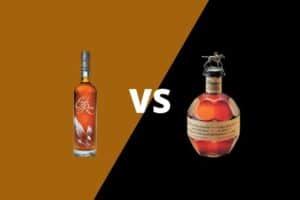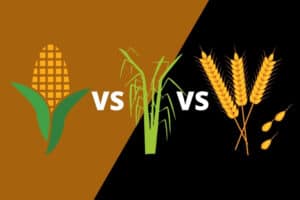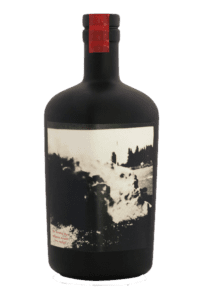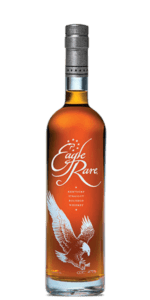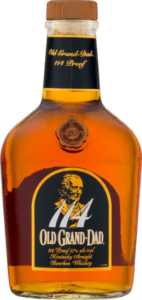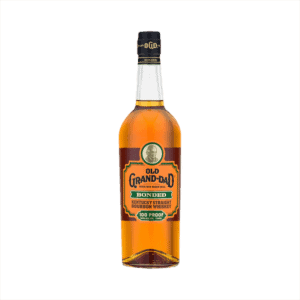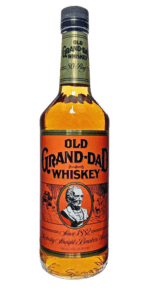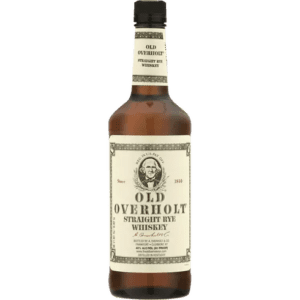‘Bourbon’ and ‘Rye’ describe two of the most prominent American whiskey styles.
They both grew from similar origins. Their histories are so intertwined that the overlap from where one style started and the other began has had a constantly-shifting border centuries in the making. Today, the terms describe distinct whiskey sub-categories whose production is codified in international trade law. And, they each offer their own unique flavor profiles to explore.
So, what makes each style unique? And what should you expect to find when trying these products?
In this blog post, we’ll pit rye vs. bourbon to discover how each evolved its own unique style.
Table of Contents
History
The histories of both Bourbon and Rye whiskeys are rooted in the United States frontier of the 18th century.
At the time, American tastes favored grape brandy distilled from wine and imported from Europe, or rum distilled in the coastal United States or Caribbean from the molasses byproduct of sugar cane cultivation.
But in the frontier region of Western Pennsylvania, any goods had to travel by wagon over treacherous mountainous terrain. Luxuries like French Cognac or Connecticut-distilled rum were nearly unobtainable.
What the hardscrabble frontier folk did have, however, was excess grain. The region’s fertile soil was perfect for growing crops and fields were planted with hearty rye grain. Come harvest time, farmers would distill any excess grain into whiskey. Distillation allowed farmers to monetize extra grain as a shelf-stable product that would not rot or mold. Plus, due to the lack of hard currency and banknotes available to pioneers, distilled spirit even acted as a form of currency that they could barter for goods and services.
As farmers continued to move west into the Kentucky territory, they carried their love of whiskey with them. However, federal policy incentivized the cultivation of corn maize in these new lands. So, in these areas, corn began to replace rye as the predominant grain during fermentation.
The Main Differences Between Rye and Bourbon
Today, Rye and Bourbon whiskeys are separate product categories defined by the U.S. Tobacco and Alcohol Tax and Trade Bureau. Each product has specific standards it must meet to use the term ‘Bourbon Whiskey’ or ‘Rye Whiskey’ on the label.
The primary difference between these two types of whiskey is the use of grain during the fermentation process. For bourbon, the primary grain is corn, while rye is made of predominantly rye grain.
One important thing to remember when using the word ‘rye’ is that the rules described above only apply to products produced in the United States. Canadian whiskies have an entirely different approach.
In Canada, the term ‘rye’ is used colloquially and distinguishes whiskey made with any proportion of rye grain from those made entirely of malted barley, wheat and/or corn. As a result, Canadian whisky producers can use the term to describe any whisky distillate that contains rye grain — which has a dramatic effect on taste — from their counterparts that grew from Scotch and Irish Whiskey traditions.
[RELATED: Bourbon vs Irish whiskey & Scotch vs Bourbon]
Additional confusion revolves around the term ‘American rye whiskey,’ which can become convoluted when speaking to overseas drinkers who often use the term interchangeably to describe any product made in North America.
It is helpful to keep this in mind when comparing products at your favorite bar or whiskey shop. In fact, bartenders of a certain age might reach for a bottle of Canadian whisky when asked to pour a glass of ‘rye.’
How Whiskey is Made
The term ‘whiskey’ describes any product made by distilling a mash made of fermented grains.
The producers start by mashing the mixture of grains. The grains are first milled into a flour-like consistency and added into the fermenter with water. The mash is cooked, which allows enzymes to convert starch molecules into fermentable sugars. Then yeast is added to begin fermentation. The yeasts consume sugars and release ethyl alcohol and carbon dioxide. After a period that can last up to a week, whiskey makers are left with a type of beer — usually about 6 percent alcohol by volume after fermentation.
Next, we will distill the beer to produce a spirit, or liquor.
The two main types of stills used for the distillation of whiskey are a traditional pot still and a column still. The term ‘copper pot still’ describes a traditional type of still that has been used in the production of whiskey and other spirits for centuries. It contains a large cylindrical or spherical pot in which the beer is heated to 173 degrees Fahrenheit – the boiling point of alcohol. Vapors rise through the head and travel through an elbow called the swan neck. They then travel to a condenser, which cools the alcohol vapor back into liquid. The pot is heated until it reaches 212 – the boiling part of water – and the remaining alcohol-free liquid is discharged. The clear alcohol spirit collected is much higher in strength than the beer from which it started.
It usually takes at least two pot distillations to achieve the desired strength to produce whiskey. After the first pass, the distillers are left with low wines — usually about 60 percent ABV. These will be redistilled to create a clear, unaged white dog or new-make spirit, usually between 125 and 150 proof off the still.
The other type of still is the column still. This invention was created near the turn of the 20th century to improve distilling efficiencies.
In this type of still, the liquid moves through a series of plates. Vapors rise through sections of the plate, while the less alcoholic liquids flow downwards. In today’s modern high-production facilities, distillers can precisely control each plate’s temperatures and pull spirit with the precise alcohol and congener levels desired to achieve the flavor profile they are after. This process is more efficient because the whiskey maker is left with a high-proof spirit after only one pass.
The Craft distilling movement has led to an increase in the use of combination stills. These devices incorporate a column atop a traditional copper pot still. This allows distillers to alternate the type of distillation to produce a variety of products.
Maturation
The maturation process transforms the clear, unaged new-make spirit into what is universally recognized as whiskey.
Both Bourbon and Rye whiskeys made in the United States must be matured in new American charred oak barrels. The spirit placed inside the barrel cannot exceed 125-proof in strength. A ‘Straight Rye Whiskey’ or a ‘Straight Bourbon Whiskey’ is a product that has been aged for at least two years in a bonded warehouse.
Canadian distillers do not have to follow these guidelines and primarily mature their products in barrels that were previously used to age American bourbon, rye or Tennessee whiskey products.
What is Rye whiskey
To carry the term Rye whiskey on the label, a product from the United States must be made from a mash of at least 51 percent rye grain. The remaining ‘secondary grains’ are usually composed of malted barley, wheat and/or corn.
Types of Rye
Rye whiskey is a creation born of North America.
In the Old World, whiskey traditions centered around malted barley. In Europe, barley was a common crop used for human consumption, livestock feed and beer production. But before refrigeration was available, excess crops and beer could quickly rot or spoil.
It didn’t take long for farmers to realize that distilling malted barley into spirits offered a shelf-stable commodity that would last for years or decades if stored properly. In fact, the first written evidence of Irish whiskey production comes from about 1000 AD!
Barley has many properties that made it a favorite for early brewers and distillers. By malting barley, brewers isolate enzymes that naturally convert starch molecules in the grain into shorter glucose molecules yeast can consume during fermentation. In a time before chemistry, brewers recognized that if they soaked barley grain in water to force germination, then abruptly stopped the germination process by heating the kernels, they could produce a liquid that would ferment into alcohol.
Irish, Scots and German immigrants to the New World brought their brewing and whiskey traditions from Europe. But the ingredients changed to meet America’s unique climate and landscape.
The rich, fertile soil in North America was perfect for the cultivation of rye grain, which grew in abundance. Brewers and distillers began to make alcohol to utilize grain stocks available to them. They soon realized that despite its stubborn ability to foam over and gum up still works, the addition of spicy rye grain created a spirit with a rich taste and complex flavor. Soon, drinkers across North American described this new spirit as ‘rye’ to distinguish it from its European cousin, made primarily of malted barley.
After the American Revolution, the style of Rye whiskey made in the United States began to diverge into a different type of whiskey than its Canadian counterpart. Let’s explore some of those differences.
American Rye
Rye whiskeys produced in the United States must be matured in new American charred oak barrels.
Whiskeys produced in the United States are typically made from a combination of mashed grains, distilled and matured in the barrel before being dumped and bottled. A typical rye whiskey, for example, may contain 75 percent rye content, 12.5 percent malted barley and 12.5 percent wheat.
Canadian Rye
Canadian distillers can use the term rye on any whiskey bottle, as long as some portion of the final product contains whiskey made with any proportion of rye grain.
Canadian whiskies often mature their spirit in used barrels.
Canadian distillers primarily make blended whisky products. They will distill blending whiskies from corn and wheat, and separate ‘flavouring’ whiskies made from predominantly rye. Flavouring whiskies will be mashed, distilled and matured separately from the blending whiskies, and only combined after the maturation process to create the final product.
While this is not always the case – Canada is internationally renowned for some fantastic 100 percent rye products – it is worth considering the implications of nuanced labeling law when comparing two products from different sides of the 45th parallel.
Popular Rye Offerings
Old Overholt – We begin this list with Old Overholt, a historic brand whose value segment pricing and name recognition lead to impressive sales volume. As a result, this brand is a favorite for bar managers looking to build profitable cocktail lists.
Wild Turkey Rye 101 – Retired Master Distiller Jim Russel was distilling rye-forward bourbon way before it was cool. It’s only fitting that Wild Turkey 101 Rye Whiskey is one of the best values on the market.
Lot No. 40 Canadian – This is an excellent example of a Canadian Rye whiskey. Because it is not aged in new American charred oak barrels, it could not be labeled as Rye whiskey in the U.S. It is made from 100 percent rye mashbill and lovingly made with Craft whiskey attention-to-detail, and it is a favorite among knowledgeable whiskey fans.
Alberta Rye – Oh, Canada! If there was any doubt Canadians could make world-class rye whiskey, this product proved it. The cask-strength version was named Best Whiskey in the World in Jim Murray’s 2021 Whisky Bible. The American whiskey drinker will be glad to know this brand has recently begun shipping to the United States.
WhistlePig – This brand is an homage to mass appeal. ‘Apprentice’ contestant Raj Bhakta created this brand to take advantage of the premiumization trend in Craft whiskey. Initially distilled in Canada, the brand now has its own distilling operation up-and-running at its home base in Vermont.
Sazerac Rye – This brand has a historical pedigree, which dates back to the 19th century, when distillers in the Ohio River valley would ship whiskey in oak barrels down the Mississippi River to the delta at New Orleans. Some historians credit these spirits brokers with recognizing the added value of wood barrel maturation.
Popular Rye Cocktails
Manhattan – The Manhattan cocktail is the perfect drink for someone new to the rye whiskey category. It is made with rye, sweet red vermouth, Angostura bitters and topped with a maraschino cherry.
Sazerac – This cocktail was a pre-Prohibition favorite that is enjoying a revival. It is made with an Absinthe rinse, rye, sugar cube, bitters and served with a lemon twist.
What is Bourbon whiskey
To carry the term bourbon whiskey on the label, a product must be made in the United States from a mash of at least 51 percent corn. The remaining ‘secondary grains’ are usually composed of malted barley, wheat and/or rye.
Bourbon must be matured in new American charred oak barrels.
Through international trade agreements, only products made in the United States can carry the term bourbon on the label. So unlike Rye whiskeys, there is no worry of there being any cross-border confusion when comparing products. No Canadian product is eligible to use this term on any of its packaging.
Types of Bourbon
Most bourbons are made with four main ingredients: 51 percent or more corn, along with rye, wheat and malted barley. The corn content is what gives bourbon its relatively sweeter taste.
Innovation has led to diversity within the bourbon category over the decades. Let’s take a look at some of the popular sub-categories of bourbon that describe approaches whiskey makers take when distilling their products. These changes in the production process create subtle differences that are appreciated by whiskey aficionados around the world.
Traditional
A traditional bourbon is made with at least 51 percent corn, with the remainder split evenly between malted barley, corn and wheat. Often, the corn ratio is much higher – about 75 percent, leading to more of the sweet corn flavor making its way into the finished product.
High-Rye
A high-rye bourbon describes a product in which the rye grain’s unmistakably spicy character is pronounced in the final product. Like all bourbons, high-rye is made with at least 51 percent corn, but with a higher proportion of rye. A typical high-rye bourbon might contain 25 percent rye in the mashbill.
High-rye bourbon should not be confused with a rye whiskey, which is 51 percent rye.
Wheated
A ‘wheated’ bourbon describes a product with a smooth flavor that contains little-to-no spicy rye characteristics. Made with at least 51 percent corn, distillers use wheat as the primary flavoring grain when producing a wheated product.
Tennessee Whiskey
Tennessee whiskey is not bourbon. We mention it here because it is a close cousin. It is made to the same bourbon standards, but lawmakers in that state have added additional provisions: Whiskey must be produced in Tennessee and undergo the Lincoln County process in which spirit is run through sugar maple charcoal before entering the barrel. It is a caveat worth mentioning because Jack Daniel’s Tennessee Whiskey is the No. 1-selling brand among American whiskeys.
Popular Bourbon Offerings
Jim Beam – Jim Beam Kentucky Straight Bourbon Whiskey is the No. 1 selling bourbon in the U.S. and internationally.
Maker’s Mark – Maker’s Mark is an excellent example of a wheated bourbon. Distillers use soft red winter wheat for a smooth-tasting bourbon.
Even Williams – Evan Williams is the No. 2 selling bourbon in the United States in sales volume. It’s the perfect value segment product for bar managers hoping to boost drink sales.
Wild Turkey 101 – This brand helped pioneer the high-rye, bonded-proof, high-impact whiskey profile fans now appreciate at a time when most brands were trending for a lighter and milder flavor profile.
Popular Bourbon Cocktails
Mint Julep – Nothing is more Kentucky than a mint julep cocktail on a hot, muggy derby day. It is made with shaved ice, bourbon, fresh lime, mint sprigs and powdered sugar.
Old Fashioned – Old school. The bourbon old fashioned is essential when discussing classic cocktails. It consists of bourbon, Angostura bitters, sugar cube, dash of water and served with an orange peel.

